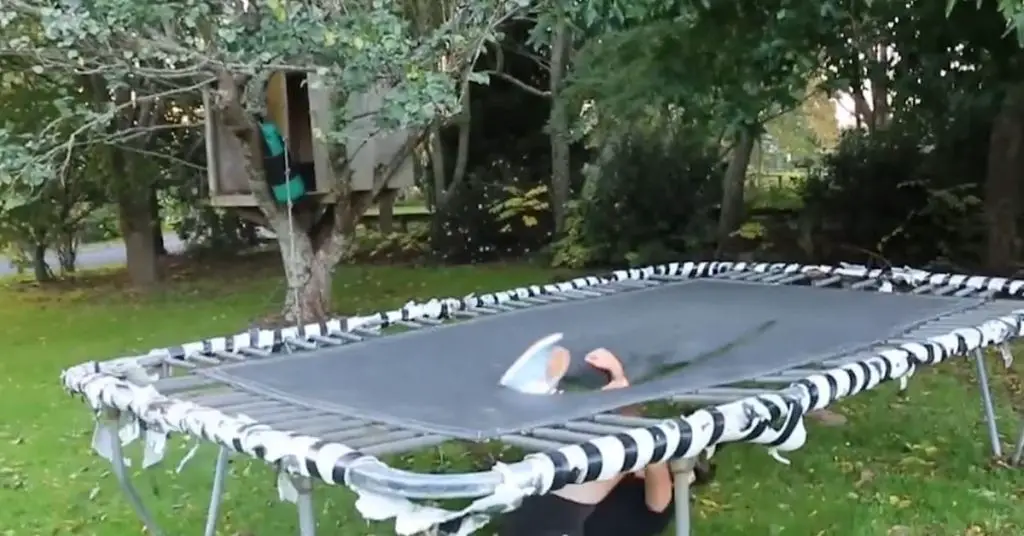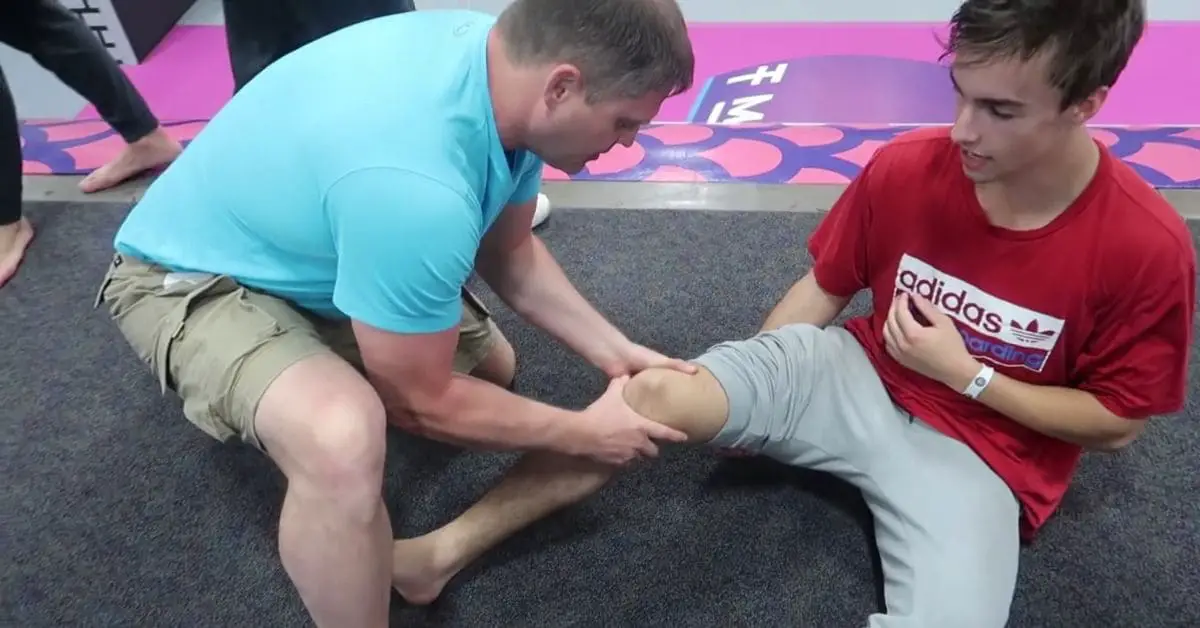Breaking a leg on a trampoline is a severe concern for many individuals, especially parents considering purchasing a trampoline for their children. While trampolines can be enjoyable, they also pose a risk for various injuries, including leg fractures. Understanding how these injuries can occur is essential for anyone who plans to use a trampoline.
Factors such as inadequate supervision, improper use, and lack of safety measures can increase the risk of leg injuries on trampolines. Fortunately, there are steps you can take to prevent these injuries and ensure that your trampoline use is as safe as possible.
By following proper guidelines and best practices, you can enjoy the benefits of trampolining without putting yourself or your loved ones at risk. In this article, we will explore the common causes of leg injuries on trampolines and provide tips on preventing them.
How to break your leg on a trampoline:
Breaking a leg on a trampoline is a serious concern for many people. Improper use, inadequate supervision, and lack of safety measures are some of the factors that can increase the risk of leg injuries on trampolines.
Understanding Trampoline Injuries
Trampolines are a popular recreational activity enjoyed by people of all ages. They provide an enjoyable way to exercise, socialize and have fun with friends and family. However, they also pose a risk of injury if not used correctly.
We will discuss the types of injuries associated with trampolines and how they can be prevented.
Broken Bones

Broken bones are one of the most common injuries associated with trampolines. They can occur when a person lands awkwardly or collides with another person on the trampoline.
Children are particularly vulnerable to this type of injury, as their bones are still developing and can be more easily fractured. Common types of broken bones associated with trampolines include wrist, ankle, and leg fractures.
To prevent broken bones, it is important to ensure that the trampoline is set up correctly and that the safety net is adequately secured. Children should be supervised while using the trampoline and instructed to jump in the center of the mat, away from the edges. Additionally, only one person should be on the trampoline simultaneously to avoid collisions.
Sprains and Strains
Sprains and strains are also common injuries associated with trampolines. They can occur when a person lands awkwardly or twists their ankle or knee while jumping.
These types of injuries can be painful and may require medical attention. Symptoms may include swelling, bruising, and difficulty walking.
To prevent sprains and strains, it is important to warm up before using the trampoline and to stretch properly. Additionally, it is important to use the trampoline on a level surface and to avoid jumping too high or attempting complex maneuvers.
Concussions and Head Injuries
Concussions and head injuries are some of the most severe injuries associated with trampolines. They can occur when a person lands on their head or collides with another person on the trampoline.
Symptoms of a concussion may include headache, dizziness, and confusion.
To prevent concussions and head injuries, it is important to use the trampoline safely and to avoid attempting risky maneuvers.
Children should be instructed to jump in the center of the mat and to avoid jumping too high. Additionally, helmets can be worn to protect against head injuries.
Common causes of injuries
Trampolines are a popular recreational activity, providing an enjoyable way to exercise and socialize with friends and family. However, they also pose a risk of injury if not used correctly or with adequate safety measures.
We will discuss the common causes of trampoline injuries and how they can be prevented.
Lack of Supervision
A lack of supervision is one of the most common causes of trampoline injuries. Children, in particular, may be unaware of the risks involved in trampolining and may not understand how to use the equipment safely.
As a result, they may attempt risky maneuvers or jump in ways that can lead to injury. Without proper supervision, children may also collide with each other or fall off the trampoline, leading to broken bones, sprains, and other injuries.
To prevent injuries caused by a lack of supervision, it is important to supervise children at all times while they are using the trampoline. Parents or guardians should ensure that children use the trampoline safely and follow safe jumping practices. Additionally, children should be instructed to jump in the mat’s center and avoid attempting risky maneuvers.
Incorrect Use of Trampolines

Another common cause of trampoline injuries is the incorrect use of the equipment. This can include jumping too high or attempting risky maneuvers like flips or somersaults. Also, improper use of the safety net or failure to secure the trampoline can lead to injuries.
It is important to follow safe jumping practices to prevent injuries caused by the incorrect use of trampolines. This includes jumping in the center of the mat and avoiding attempting complex maneuvers. Additionally, the trampoline should be set up correctly and secured with a safety net to prevent falls.
Inadequate Safety Measures
Inadequate safety measures are another common cause of trampoline injuries. This can include the absence of safety netting or failing to use a safety harness or helmet. Injuries can occur without proper safety measures due to falls, collisions, or other accidents.
To prevent injuries caused by inadequate safety measures, using the proper safety equipment while using the trampoline is important. This includes using a safety harness or helmet, securing the trampoline with a safety net, and ensuring that the trampoline is set up on a level surface.
How to break your leg on a trampoline?
Trampolining can be a fun and exciting way to exercise and spend time with friends and family. However, it can also be dangerous, and leg injuries are common on trampolines.
We will discuss the types of leg injuries that can occur on trampolines, factors that increase the risk of leg injuries, and prevention tips to help reduce the risk.
Types of Leg Injuries on Trampolines
Fractures – Fractures are common leg injuries on trampolines, and they can range in severity from a hairline fracture to a complete break. Fractures can occur from landing incorrectly or colliding with another person on the trampoline.
Sprains and strains – Sprains and strains are also common leg injuries on trampolines. These injuries can occur from landing incorrectly or overexertion, such as performing too many jumps or stunts.
Dislocations – Dislocations are another type of leg injury that can occur on trampolines. These injuries can occur from landing incorrectly or from colliding with another person on the trampoline.
Factors that Increase the Risk of Leg Injuries
Lack of supervision – A lack of supervision can increase the risk of leg injuries on trampolines. Children may attempt risky maneuvers without proper supervision or jump in ways that can lead to injury.
Incorrect use of the trampoline – Incorrect use of the trampoline can also increase the risk of leg injuries. This can include jumping too high or attempting risky maneuvers like flips or somersaults.
Inadequate safety measures – Inadequate safety measures, such as the absence of safety netting or failing to use a safety harness or helmet, can increase the risk of leg injuries on trampolines. Injuries can occur without proper safety measures due to falls, collisions, or other accidents.
Poor maintenance – Poor trampoline maintenance, such as worn or damaged parts, can also increase the risk of leg injuries.
Prevention Tips for Leg Injuries
Supervision – Children should always be supervised while using the trampoline to reduce the risk of leg injuries on trampolines. Parents or guardians should ensure that children use the trampoline safely and follow safe jumping practices.
Safe jumping practices – Following safe jumping practices can also help reduce the risk of leg injuries on trampolines. This includes jumping in the center of the mat, avoiding attempting complex maneuvers, and not jumping too high.
Proper safety equipment – Using the proper safety equipment while using the trampoline can also help reduce the risk of leg injuries. This includes using a safety harness or helmet, securing the trampoline with a safety net, and ensuring that the trampoline is set up on a level surface.
Regular maintenance – Regular maintenance of the trampoline, including checking for worn or damaged parts, can also help reduce the risk of leg injuries.
Proper footwear – Wearing proper footwear while using the trampoline can also help reduce the risk of leg injuries. Sneakers with good support and grip can help prevent slipping and provide extra support for the feet and ankles.
Can You Break a Bone on a Trampoline?

Trampolining is a popular recreational activity that provides a fun way to exercise, but it can also be dangerous, and bone injuries are not uncommon on trampolines. In this article, we will discuss the types of bone injuries that can occur on trampolines, factors that increase the risk, and prevention tips to help reduce the risk of injury.
Types of Bone Injuries on Trampolines
Fractures are common bone injuries on trampolines and can range from minor to severe. Fractures can occur from landing incorrectly or from colliding with another person on the trampoline.
Dislocations – Dislocations are another type of bone injury that can occur on trampolines. They can occur when the bone is forced out of its normal position, which can result in severe pain, swelling, and difficulty moving the affected area.
Sprains and Strains – Sprains and strains are also common bone injuries on trampolines. They can occur from landing incorrectly or overexertion, such as performing too many jumps or stunts.
Factors that Increase the Risk of Bone Injuries
Lack of supervision – A lack of supervision can increase the risk of bone injuries on trampolines. Children may attempt risky maneuvers without proper supervision or jump in ways that can lead to injury.
Incorrect use of the trampoline – Incorrect use of the trampoline can also increase the risk of bone injuries. This can include jumping too high or attempting risky maneuvers like flips or somersaults.
Inadequate safety measures – Inadequate safety measures, such as the absence of safety netting or failing to use a safety harness or helmet, can increase the risk of bone injuries on trampolines. Injuries can occur without proper safety measures due to falls, collisions, or other accidents.
Poor maintenance – Poor trampoline maintenance, such as worn or damaged parts, can also increase the risk of bone injuries.
Prevention Tips for Bone Injuries

Supervision – Children should always be supervised while using the trampoline to reduce the risk of bone injuries on trampolines. Parents or guardians should ensure that children use the trampoline safely and follow safe jumping practices.
Safe jumping practices – Following safe jumping practices can also help reduce the risk of bone injuries on trampolines. This includes jumping in the center of the mat, avoiding attempting complex maneuvers, and not jumping too high.
Proper safety equipment – Using the proper safety equipment while using the trampoline can also help reduce the risk of bone injuries. This includes using a safety harness or helmet, securing the trampoline with a safety net, and ensuring that the trampoline is set up on a level surface.
Regular maintenance – Regular maintenance of the trampoline, including checking for worn or damaged parts, can also help reduce the risk of bone injuries.
Proper footwear – Wearing proper footwear while using the trampoline can also help reduce the risk of bone injuries. Sneakers with good support and grip can help prevent slipping and provide extra support for the feet and ankles.
Weight limit – Trampolines have weight limits that should be followed to avoid damage to the trampoline and injury to users. Overloading the trampoline can increase the risk of bone injuries.
One person at a time – Only one person should use the trampoline to avoid collisions and reduce the risk of bone injuries.
How Do You Break Your Foot on a Trampoline?
Trampolining is a popular activity that provides a fun way to exercise, but it can also be dangerous, and foot injuries are not uncommon on trampolines. In this article, we will discuss the causes of foot injuries that can occur on trampolines and prevention tips to help reduce the risk of injury.
Causes of Foot Injuries on Trampolines
Landing incorrectly – Landing incorrectly on the trampoline can cause foot injuries. This can occur when a person lands with their feet turned inward or outward or lands with their foot at an awkward angle.
Colliding with another person – Collisions with another person on the trampoline can also cause foot injuries. This can occur when two people jump simultaneously and land on each other’s feet.
Overuse – Overusing the feet while jumping can also lead to foot injuries. This can occur from jumping for an extended period or attempting risky maneuvers, such as flips or somersaults.
Prevention Tips for Foot Injuries
Proper footwear – Wearing proper footwear while using the trampoline can help reduce the risk of foot injuries. Sneakers with good support and grip can help prevent slipping and provide extra support for the feet and ankles.
Safe jumping practices – Following safe jumping practices can also help reduce the risk of foot injuries. This includes jumping in the center of the mat, avoiding attempting complex maneuvers, and not jumping too high.
Regular breaks – Taking regular breaks while jumping on the trampoline can also help reduce the risk of foot injuries. This can help prevent overuse and fatigue of the feet.
One person at a time – Only one person should use the trampoline to avoid collisions and reduce the risk of foot injuries.
Proper supervision can also help reduce the risk of foot injuries on trampolines. Children should always be supervised while using the trampoline, and parents or guardians should ensure that they use it safely and follow safe jumping practices.
Proper use of the trampoline – Proper use of the trampoline can also help reduce the risk of foot injuries. This includes jumping in a controlled manner, avoiding landing at awkward angles, and avoiding jumping too high.
Regular maintenance – Regular maintenance of the trampoline, including checking for worn or damaged parts, can also help reduce the risk of foot injuries.
How to Prevent Trampoline Injuries
Trampolining is a fun and popular form of exercise and entertainment, but it also carries the risk of injury. However, by following safety guidelines and taking necessary precautions, many trampoline injuries can be prevented.
We will discuss how to prevent trampoline injuries through safety guidelines, supervision and monitoring, and maintenance and care of trampolines.
Safety Guidelines for Trampolines

Use safety equipment – Safety equipment, such as safety nets, padding, and helmets, can help prevent injuries. Ensure all safety equipment is properly installed and in good condition before using the trampoline.
Proper use – Proper use of the trampoline is essential to prevent injuries. This includes using the trampoline on level ground, jumping in the center of the mat, and avoiding attempting complex maneuvers.
One person at a time – Only one person should use the trampoline to reduce the risk of collisions and injuries.
Weight limits – Trampolines have weight limits that should be strictly adhered to. Overloading the trampoline with too much weight can cause it to malfunction and increase the risk of injury.
No somersaults – Somersaults are one of the most dangerous maneuvers that can be performed on a trampoline. They should not be attempted, especially by inexperienced users.
Supervision and Monitoring of Trampoline Use
Children should be supervised – Children should always be supervised while using the trampoline. Adults should ensure that children use the trampoline safely and follow safe jumping practices.
No unsupervised use – The trampoline should never be used without supervision, especially by children.
Monitor the number of users – The number of people using the trampoline should be monitored to reduce the risk of collisions and injuries.
Maintenance and Care of Trampolines
Regular inspection – The trampoline should be regularly inspected for wear and tear, damaged parts, and loose connections. Any issues should be addressed immediately to prevent injuries.
Repair or replace worn or damaged parts – Any worn or damaged parts should be repaired or replaced before using the trampoline to prevent injuries.
Proper storage – The trampoline should be properly stored when not in use to prevent damage from weather or other environmental factors.
Follow manufacturer’s instructions – It is important to follow the manufacturer’s instructions for the trampoline’s assembly, maintenance, and care.
FAQs
Q.1 What are the most common injuries associated with trampolines?
The most common trampoline injuries include sprains and strains, broken bones, and head injuries. These can occur from falls, collisions, or attempting complex maneuvers.
Q.2 Can I break my leg on a trampoline?
Yes, it is possible to break your leg on a trampoline. Leg injuries can occur from awkward landings or colliding with another user on the trampoline.
Q.3 How can I prevent injuries while using a trampoline?
Several ways to prevent trampoline injuries include using safety equipment, following proper use guidelines, limiting the number of users, and regularly inspecting and maintaining the trampoline.
Q.4 Can children use trampolines safely?
Children can use trampolines safely with proper supervision and following safe jumping practices. However, they should never be left unsupervised on a trampoline.
Q.5 Is it safe to attempt somersaults on a trampoline?
Attempting somersaults on a trampoline is highly dangerous and can result in serious injury. It is best to avoid attempting complex maneuvers unless you are an experienced and trained trampolinist.
Q.6 What should I do if I experience an injury on a trampoline?
If you experience an injury on a trampoline, seek medical attention immediately. It is also important to properly care for the injury, such as following the RICE method (rest, ice, compression, elevation).
Q.7 How often should I inspect my trampoline for wear and tear?
You should inspect your trampoline regularly, at least once a month, for wear and tear, damaged parts, and loose connections. Any issues should be addressed immediately to prevent injuries.
Conclusion
In conclusion, trampolines can be a fun activity for people of all ages, but they also pose a risk of injury. Some common injuries associated with trampoline use include broken bones, sprains, strains, concussions, and head injuries. Lack of supervision, incorrect use of trampolines, and inadequate safety measures are common causes of injuries.
Leg injuries, including broken bones and sprains, are a common type of injury that can occur on trampolines. Factors that increase the risk of leg injuries include improper use of the trampoline, lack of supervision, and inadequate safety measures. Prevention tips for leg injuries include using safety nets or padding, following proper safety guidelines, and avoiding risky stunts.
Bone injuries on trampolines can be severe and require medical attention. Factors that increase the risk of bone injuries include improper use of the trampoline, lack of supervision, and inadequate safety measures. Prevention tips for bone injuries include using safety nets or padding, following proper safety guidelines, and avoiding risky stunts.
Foot injuries, including broken bones and sprains, are another type of injury that can occur on trampolines. Causes of foot injuries on trampolines include improper trampoline use and lack of supervision. Prevention tips for foot injuries include wearing proper footwear, using safety nets or padding, and avoiding risky stunts.
To prevent trampoline injuries, it’s essential to follow proper safety guidelines, including supervision and monitoring of trampoline use, maintenance, and care of trampolines, and following proper safety guidelines. By prioritizing safety, trampoline use can be a fun and safe activity for everyone to enjoy.
After reading this detailed guide on how to break your leg on a trampoline, we hope you are now more aware of the dangers involved. If you have any questions or concerns, please feel free to comment below!

